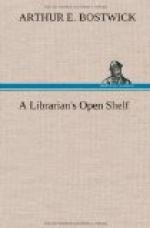The development of therapeutic measures that are independent of drugs has been coincident with popular emancipation from the mere superstition of drug-administration. The older lists of approved remedies were loaded with items that had no curative properties at all, except by suggestion. They were purely magical—the thumb-nails of executed criminals, the hair of black cats, the ashes of burned toads and so on. Even at this moment your pharmacopoeia contains scores of remedies that are without effect or that do not produce the effects credited to them. I am relying on high therapeutical authority for this statement. Now when the sick man is told by his own physician to discard angleworm poultices, and herbs plucked in the dark of the moon, on which he had formerly relied, it is any wonder that he has ended by being suspicious also of calomel and ipecac, with which they were formerly classed? And when the man who believed that he received benefit from some of these magical remedies is told that the result was due to auto-suggestion, is it remarkable that he should fall an easy prey next day to the Christian Scientist who tells him that the effects of calomel and ipecac are due to nothing else than this same suggestion? The increased use and undoubted value of special diets, serums, aseptic surgery, baths, massage, electrical treatment, radio-therapeutics, and so on, makes it easy for him to discard drugs altogether, and further, it creates, even among those who continue to use drugs, an atmosphere favorable to the belief that they are back numbers, on the road to disuse. Just here comes in the second factor to persuade the layman, from what has come under his own observation, that drugs are injurious, dangerous, even fatal. Newly discovered chemical compounds with valuable properties, have been adopted and used in medicine before the necessary time had elapsed to disclose the fact that they possessed also other properties, more elusive than the first, but




